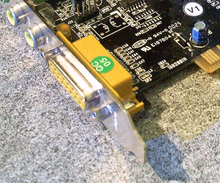 A DA-15 connector on a sound card | |||
| Type | Joystick input port | ||
|---|---|---|---|
| Production history | |||
| Designer | IBM | ||
| Superseded by | USB | ||
| General specifications | |||
| Hot pluggable | Yes | ||
| External | Yes | ||
| Pins | 15 | ||
| Connector | DA-15 | ||
| Pinout | |||
 | |||
| Pin 1 | +5V | +5 V DC | |
| Pin 2 | B1 | Button 1 | |
| Pin 3 | X1 | X-axis for joystick 1 (0–100 kΩ) | |
| Pin 4 | GND | Ground for B1 | |
| Pin 5 | GND | Ground for B2 | |
| Pin 6 | Y1 | Y-axis for joystick 1 (0–100 kΩ) | |
| Pin 7 | B2 | Button 2 | |
| Pin 8 | +5V | +5 V DC | |
| Pin 9 | +5V | +5 V DC | |
| Pin 10 | B3 | Button 3 (B1 for joystick 2) | |
| Pin 11 | X2 | X-axis for joystick 2 (0–100 kΩ) | |
| Pin 12 | GND | Ground for buttons 3 and 4 (or MIDI out) | |
| Pin 13 | Y2 | Y-axis for joystick 2 (0–100 kΩ) | |
| Pin 14 | B4 | Button 4 (B2 for joystick 2) | |
| Pin 15 | +5V | +5 V DC (or MIDI in, sometimes unconnected) | |
The game port is a device port that was found on IBM PC compatible and other computer systems throughout the 1980s and 1990s. It was the traditional connector for joystick input, and occasionally MIDI devices, until made obsolete by USB in the late 1990s.
Originally located on a dedicated Game Control Adapter expansion card, the game port was later integrated with PC sound cards, and still later on the PC's motherboard. During the transition to USB, many input devices used the game port and a USB adapter dongle was included for systems without a game port.